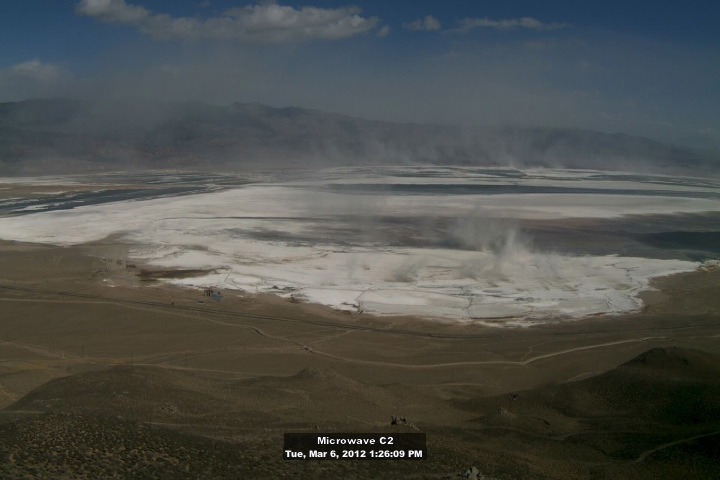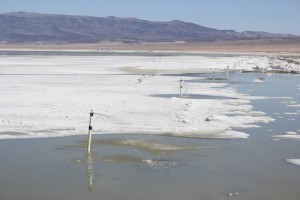LADWP: cheaper to fight than fix
Posted on | March 6, 2012 | 11 Comments

Dust off Owens Lake, March 6, 2012. Source: Great Basin Unified Air Pollution Control District. Click on the image to be taken to district "dust cams."
After suppressing 90% of Owens Valley dust caused by a century of Los Angeles siphoning Eastern Sierra water, the LA Department of Water & Power has sued to stop further remediation work. The move under sophomore DWP general manager Ron Nichols appears to be part of a greater strategy to increase water exports while leaving the affected rural communities tied up in court. The shift under Nichols marks a sharp reversal of the largely good neighbor policy pursued by the four preceding general managers to have served since 2005 under LA Mayor Antonio Villaraigosa.
As background, diversion of water from Owens River starting in 1913 soon left what was once the crystalline Owens Lake a roughly 100-square-mile, largely dry playa whose sand and salts are whipped aloft each year by winter and spring gales. By the 1980s, billowing dust from the dry lakebed made Owens Valley the source of the worst “particulate matter” air pollution in the US, 130 times higher than levels permitted under federal guidelines. Contained in the swarming grit was not just high desert sand, but also arsenic, salt and cadmium.
Forced by lawsuits along with federal and state intervention, eleven years ago LADWP began a series of dust suppression measures in Owens Valley. Strategic flooding of the lake bed, planting it with salt grass and dumping gravel have since contained fugitive dust from 40 of roughly 46.5 square miles identified so far by the Great Basin Unified Air Pollution Control District as the most volatile areas. According to the district, the measures have successfully contained 90% of the dust emissions. Arguing its case in a recent press release, the LADWP claims to be closing in on 96% containment. But suppressing the dust has also forced Los Angeles to leave roughly a third of its target mountain water behind and, according to the DWP, cost ratepayers a billion dollars.

LADWP spigots dump water on Owens Dry Lake to suppress dust on March 1, 2012. Five days later, caught in the top photograph, dust still billowed from un-treated parts of the bed. Photo: Emily Green
How much of this billion was wasted has never been spelled out. Little is known about the upshot of a 2008 lawsuit brought by the second of the current mayor’s succession of now five DWP general managers against the city’s own engineering consultants. But contractual beefs aside, back in Owens Valley, a billion dollars seems cheap. In a press release countering DWP’s claims, the officer in charge of the Owens Valley air pollution control district pointed out that the rate being paid by DWP is one-fifth the price deemed cost-effective by LA’s own local South Coast Air Quality Management District.
Why the sudden cynicism putting urban dollars over rural lungs? The answer seems to be that classic LA cocktail of money and water. In a rain and snowpack year likely to return California to official drought status, LA wants to redirect at least some of the current 29 billion gallons of water presently employed in Owens Valley dust suppression to the aqueduct that Mulholland built. Lest anyone doubt DWP’s sudden taste for hardball, since former energy broker Ron Nichols was appointed DWP general manager little more than a year ago, the DWP has even filed suit against the Eastern Sierra ski resort of Mammoth, arguing that LA owns the water in a creek supplying 50% of the town’s water. This though yearly water use by Mammoth is less than the estimated sprinkler overflow from parkway strips into storm drains in ten summer days in greater Los Angeles.
As an upshot of the sudden litigiousness from LA, look for further remediation to be stalled in court for years while DWP lawyers are likely to demand quid pro quo measures from the rural residents of the Eastern Sierra along the lines of: Keep your puny allocation from Mammoth Creek, lose six square miles of dust control that might cost four times the water.
Civic mindedness seems to have gone by the wayside as LA Mayor Villaraigosa has given a businessman a water manager’s job. Jaws dropped in February when at an Eastern Sierra meeting the DWP’s Nichols said, “Legal fees pale in comparison to the cost of dust control.” Within days, Nichols’ department had served Owens Valley air managers with a writ announcing that the DWP intended to stop any further dust remediation. According to the Great Basin Unified Air Pollution Control District, as LA’s lawyers move in, dust pollution in Owens Valley stands at ten times the accepted federal level. The top photo, taken today, comes as winter winds mobilized the sand and salts of the un-treated remaining 10% of the dry lakebed.

Salt grass irrigated by drip lines is an effective and relatively attractive dust control measure in Owens Dry Lake, March 2012. Eventually the hope of an Owens Valley Master Plan Committee is to more artfully integrate planted and wetted areas while also reducing water required from DWP. Click on the photo to be taken to the website of the Master Plan committee. Photo: Emily Green
For updates, follow Aquafornia, the newsfeed of the Water Education Foundation. Click here for a slide-show recounting the history of the Los Angeles Aqueduct that tapped the Eastern Sierra by Aquafornia editor Chris Austin.
Correction: The original version of this post said that Mammoth’s yearly withdrawal of 3,000 acre feet of water from Mammoth Creek was the equivalent of estimated parkway run-off from sprinklers etc of one summer day in greater Los Angeles. The correct estimate is 10 summer days.
Comments
11 Responses to “LADWP: cheaper to fight than fix”
Leave a Reply



March 6th, 2012 @ 5:13 pm
thank you Emily…
March 6th, 2012 @ 6:29 pm
Excellent article. Of particular note is the paradigm shift in the Eastern Sierra water exporting strategy by LADWP and the City of Los Angeles leadership. The orders are to fight every agreement by ‘reinterpreting’ them. The classic film Chinatown was historical fiction using artistic license. What is happening right now in Inyo and Mono is for real. It is a sad reversal of what was thought to be the beginning of better relations between the City of Angels and its water colonies.
March 6th, 2012 @ 7:04 pm
Chinatown: Scene 145 @ 1:03:20 “You may think you know what you’re dealing with but believe me you don’t.”
March 6th, 2012 @ 7:10 pm
Yes, thanks, Emily.
LADWP prevailing attitude seems so typical of nature-deprived/disconnected mentality. Very sad, indeed.
March 6th, 2012 @ 8:40 pm
As resources become more scarce this kind of thing becomes more common. To squeeze out the last bit of cheap water(or energy) environmental regulations come under attack. Loss of species, air quality, water quality…….. are less important than maintaining an unsustainable way of life. We need to hear much more of the “c” word (conservation!). Very troubling.
March 6th, 2012 @ 9:18 pm
It seems such a short time ago since Mayor Villaraigosa flew to Lone Pine, opened the gate to channel some of the water back to the original channel, “Let the water flow, baby.”
http://nevada.sierraclub.org/conservation/easternsierra/OwensRiver.html
March 7th, 2012 @ 6:57 am
go pull up a Google Maps image of LA and check how many lawns you see.
If you’re watering one of them with LADWP water, you’re a part of this.
The lawns will go away in the next big drought, anyway. That could be starting this year, if we hit a few more dry years. Why not plant some native plants or succulents now so you’re ahead of the game?
March 10th, 2012 @ 7:51 pm
Came across this website by accident. This is horrible. DWP has been ignoring all the health issues and mess they’ve created down here in LA, with their new water pipeline project. Residents getting ill from Particulate Matter (and possibly contaminated soil too), damage to people’s homes & buildings. It seems as though they just do what they want to do, and then they deal with the consequences later — if they even have to.
LA Times did a story on the what I’m mentioning here, came out yesterday. But it was nearly a “love letter” to the DWP. No accountability, it allowed the DWP (and Glenn Singley) to actually lie. Publicly lie. And it made the residents here sound like “whiners” over some dust. (Story here:
http://www.latimes.com/news/local/la-me-pipe-dust-20120309,0,643731.story )
So we have corrupt city government, we have a corrupt DWP, and we have a lame LA Times that apparently can’t even do a story with any depth or that outlines the real issues.
Can’t the State or Federal government force the DWP to comply with EPA laws? Why does it have to take a law suit from residents/groups of or around Owens Valley?
March 11th, 2012 @ 12:23 pm
This is heartbreaking. I took the LADWP tour of the Owens Valley several years ago. We stole their water and left them with a mess so that we could water our lawns. We have a moral obligation to restore this and it is not too much to ask that every one of us making a sacrifice.
April 18th, 2012 @ 4:40 pm
For those interested, published today is an extensive article about DWP’s abuse down in LA, here:
http://echopark.patch.com/topics/blog-series-dwps-new-pipeline-the-real-chinatown
May 7th, 2013 @ 8:43 pm
We live in the San Fernando Valley. We removed our front lawn and replaced it with drought tolerant natives. We contoured our land to capture as much rainwater as possible. We wash our dishes in a tub and carry out dishwater to the lawn in back. We also fill a bucket with water used in the shower waiting for the warm water to arrive. Our washing machine water is piped through the wall to a 55 gallon drum with a hose attached to the bottom to water our fruit trees. I’m sure the DWP thinks much of this activity is illegal. We think it doesn’t go far enough. Enough water falls on our property for all of our needs if we were to use cisterns like they do in the Mediterranean. We could also use incinolet toilets (solar power to incinerate human waste) and add the ash to our green bins. We could be recharging our groundwater and leaving the Owens and other sources alone instead of pumping it out to sea. I think it was Wendell Berry who said, “We have taken nature’s elegant solution and divided it into multiple problems.” We can each do more to reverse that trend.